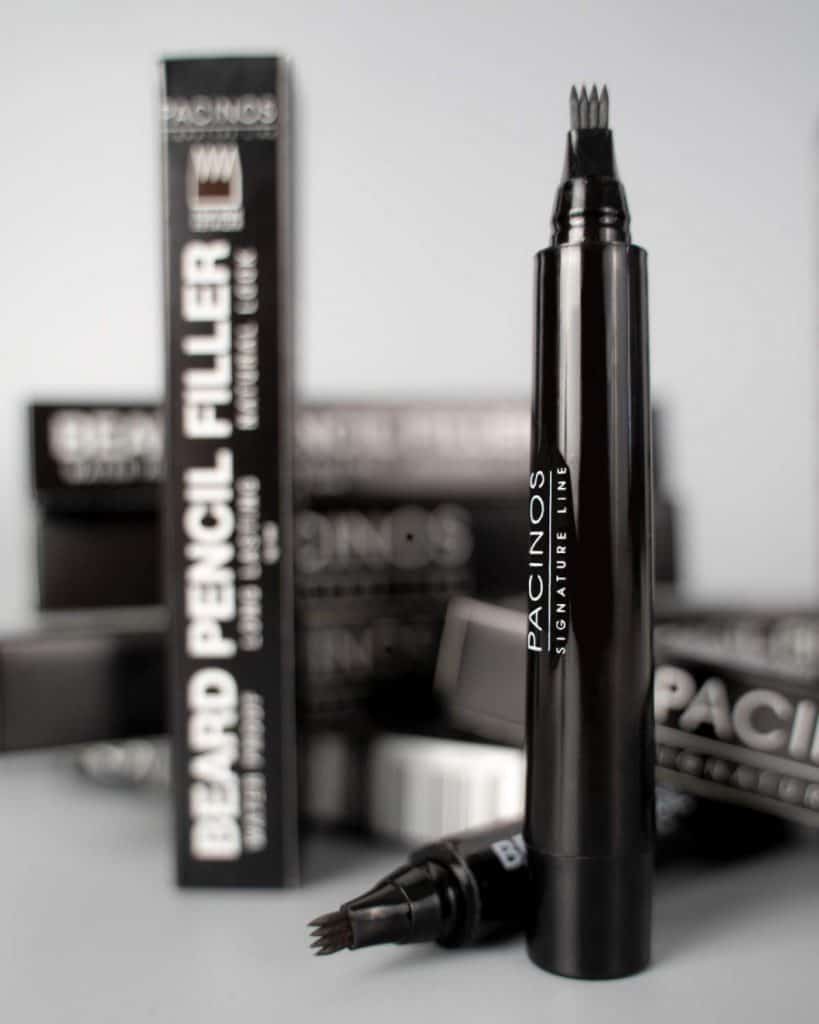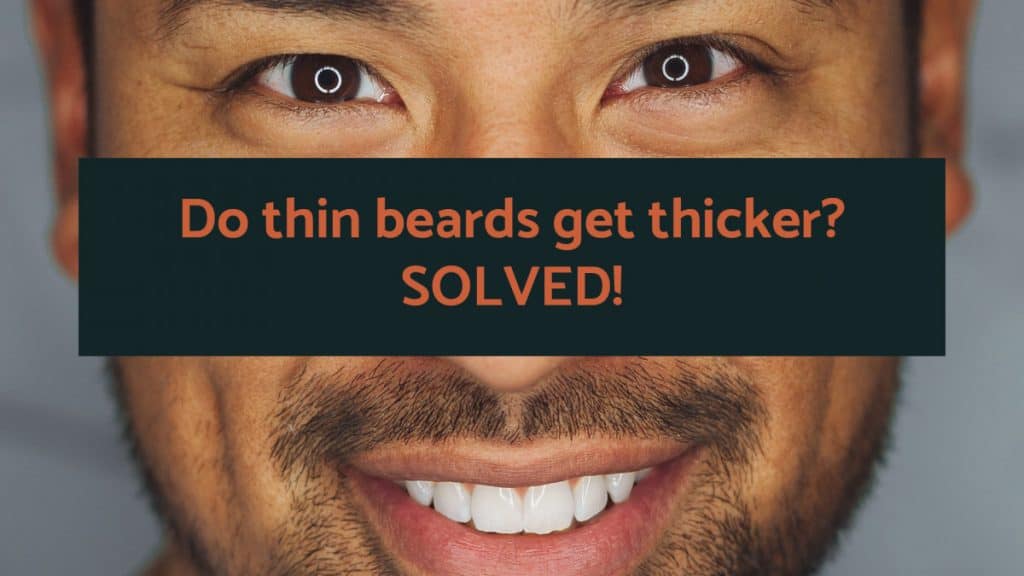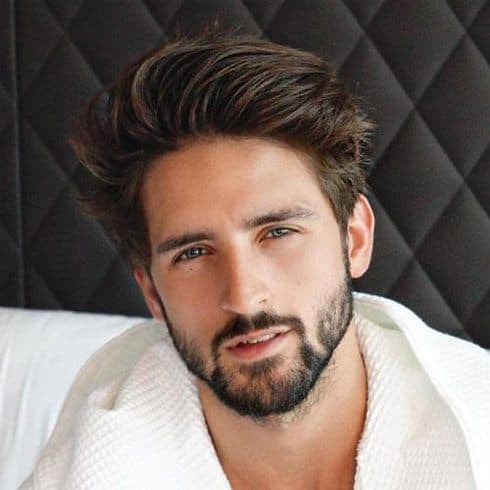While I was growing my beard I was able to notice some patches on my cheeks. A lot of men also are very critical of their beard as it is grown which results in inpatients and worry that it will not get thicker. In the majority of cases, thin beards can get thicker if you give them enough time to grow and you have the genetic predisposition for thick and dense beard growth. However, some thin beards will never get thicker as they do not have the terminal hair density required to completely connect the beard together. In this article, we will go through the science and techniques that you can use to thicken up your thin beard and also answer the worrying question: do thin beards get thicker?
Thin beards get thicker when the hairs can fill the gaps between adjoining hairs and completely cover the skin. This can be achieved by waiting for the hair to get longer or by artificially enhancing the hair using beard thickening products and surgical interventions.
We all want a thick continuous beard.
This means that the majority of men are waiting for their beard to completely cover their face so that no skin is able to be seen. Also, once the beard gets to a certain length people want their beards to look bulky and dense and not see-through.
There are a couple of reasons why people think their beard is thin. Firstly, it is that they are relatively young and haven’t yet reached the peak beard growing age. Secondly, they may have a low density of thick terminal hairs. This may change as they get older but some people never fully develop a full continuous and evenly spaced beard on their face.
My friend, even though he is 37, is not able to grow any significant beard hair on his cheeks or jaw. Unfortunately for him, the only option is to use temporary beard thickening products such as a beard pencil or Topik hair fibres to bulk up his beard. He can also use medical interventions like beard transplants and minoxidil topical treatments to encourage his vellus hairs on his face to turn into thick terminal hairs.
Before launching into a solution it is important that you understand why your beard is so thin and this will determine whether or not your beard will thicken up naturally over time.
Article Contents
Why is my beard so thin?
This is the single most important question when trying to answer the question, do thin beards get thicker? Your beard will fall into one of two categories. The first being that your hair is still thickening up because you have not yet reached your full beard growing potential. The second is that you have been awarded in the genetic lottery of life a low coverage of terminal hairs on your face.
Not reached your beard growing potential
Many people judge their beard far too early.
It is often the young beard growers that notice that they have a thin beard and start to worry that it will never thicken up.
If you have only recently been through puberty you’ll be pleased to know that there are plenty of years ahead of you to grow a thicker beard. Some people, and in my experience, notice that their beard thickens up in their late 20s and early 30s.
I scoured the Internet to find out which age people’s beards stopped filling in this was the result:

When I was growing my beard I noticed that my follicle density and hair thickness improved significantly as soon as I hit 30.
There is no “normal age” to expect to be able to grow a thick beard. It’s actually anywhere between about 16 and 40 years of age.
According to the UK’s national health system puberty begins at about 12 for boys. But this is not when you can expect to see your first beard growth – it takes much longer than that!
The first signs of puberty are that the testicles get larger and there will be a small amount of hair around the base of the penis. The testicles are where testosterone is produced and is the fuel that your beard needs to grow thick and dense!
In the later stages of puberty (one to three years after initial signs) you will start to grow thicker body hair. The hair will go from a light thin type to something much more substantial.
It can take another four years after the initial signs of puberty before boys are ready to start shaving – let alone grow a beard! The hair on the body gets progressively thicker over the course of four years.
So, if you are between the ages of 12 – 17 you probably have nothing to worry about in terms of your beard growth and you certainly shouldn’t be looking at any drastic interventions.
By the time a boy reaches the age of 18 – they will have probably been through the entire process of puberty and have reached adult maturity. If however, you are still not satisfied with the quality of your beard you can always check out my other blog posts – how to grow a beard if you can’t and how to grow hair on your cheeks.
Low terminal hair density
if you are significantly older than 18 years of age, and you are worried that your beard will not get any thicker it could be that you have a low hair density that will not change.
You see, our beards develop according to the genetic information held in our bodies.
If you do not have the right genetic markers for growing a thick and continuous beard on your face it is probable that you will never be able to grow a thick continuous beard.
Without paying for an expensive genetic test you can easily look at the relatives of your family and your cultural heritage to get an idea of whether or not you will be able to grow a beard.
Some people just can’t.
If you are in this category and you have a very low terminal hair density (A terminal hair is the result of DHT acting on vellus hair causing it to turn thick and dark) your only real options is to thicken up your beard using tools like beard pens and fibres that attach to the hair to fill in the gaps and make it appear thicker.
Also, you have the opportunity to look at surgical interventions if your beard is something that concerns you and nothing else is the right fit for what you want to achieve.
However, not all hope is lost if you cannot grow a thick beard – there are plenty of beard styles that look good without having to rely on a thick coverage of beard hair.
Before launching into the use of beard thickening products or drastic surgical interventions check out the beard styles, below.
Can a thin beard look good?
A thin beard can look good if it is intentional, well-trained, and – importantly – the owner of the beard works with what they have got and trims it accordingly.
A “good beard” is something that is very subjective but, I believe, that there are some fundamental rules which all beers need to follow in order to be perceived by the majority of people as looking good.
This includes:
- even length – a fuzzy beard which does not have defined lines can be considered scraggly and can be viewed as undesirable. I trim up my beard regularly.
- Clean lines – clean lines which separate your skin from your beard hair on areas such as your cheek line and neckline are very important for giving the impression that you have taken care of your beard. I use a single blade safety razor to clean up my lines every couple of days.
- Style – choosing a beard style that works with your growth pattern and density is one of the most important things you can do to. Luckily, my beard has filled in in my 30s which means I can adopt a full beard style easily.
Here are some thin beard styles that can look awesome. If you want to know more about thin beard styles check out my other article – thin beard styles – including expert styling tips! For much more information. Click here to be taken to article.
Of course, the above gallery of thin beard styles should only be used as a reference for deciding what will work best with your beard. For example, if your beard is thin on the cheeks you could choose a style which has a low cheek line. If, however you have a thin coverage on your jawline you can opt for a front heavy style such as a goatee or stubble with mustache.
Working with the growth pattern and density of your beard is the one thing that will turn your beard from good to great in the eyes of an outsider.
If you want to thicken up your beard there are a number of different things that you can do. In the section, below, we will go through all of the temporary and permanent ways that you can thicken up your beard to make the most of the growth that you have.
How can I thicken my thin beard?
Thickening your beard can be achieved by waiting for your hair to get long enough to cover up any gaps, you can use temporarily thickening solutions like a beard pen or hair fibres, and you can also look at successful medical interventions such as hair transplants and minoxidil.
Before you jump into the expensive and potentially risky world of surgical treatment for your thin beard you can explore the temporary solutions to see if they solve the anxiety that you have built up around the density and thickness of your beard.
Wait
There is a common joke on my YouTube channel which subscribers often point out that the solution to nearly every beard problem is to wait.
Waiting for your beard to get thicker is particularly important if you have only recently started to notice the hairs on your face turning from light to dark hairs. Or if you are under the age of 21.
Waiting is an important part of growing a beard. If you are not sure if you are seeing any increase in terminal (thick) hairs I recommend that you take a photo of your beard every week so that you can compare the coverage of thick hairs to previous photos to see if there is any progress.
Any progress, no matter how slow, should indicate to you that you need to continue to wait for your beard to reach its maximum thickness and dark hair density.
Alternatively, waiting for your beard hair to get longer – if you are older and have reached your full density – will allow you to see if your current density is able to fill in the gaps of your beard and make it look fuller.
In my experience – never underestimate what an extra inch or so of growth can do to make your beard look full and thick.
I highly recommend that you wait at least 12 weeks before deciding on whether or not you need other interventions such as a beard pen, hair fibres, or medical interventions.
There is nothing wrong with giving yourself a little bit of a perk up by using temporarily beard thickening and darkening solutions and the best on the market at the moment are beard depends and hair fibres.
Both of these have been offered by professional barbers but they are also able to be done at home. With a little bit of practice and trial and error there is no doubt that you can get it to look as good as the professionals.
Beard pen
Beard pens do exactly what a sound like – they allow you to draw in hairs so that your beard looks fuller and darker. Beard pencils come with different types of tips from a typical pen tip to one with a micro fork. This micro fork allows you to apply more product to your face in a shorter period of time. The Beard filler is designed to reduce the appearance of gaps in your Beard, moustache, and eyebrows.

It’s as easy as using a pen and it lasts all day. The long-lasting formula of many Beard pen and pencils allows you to wear the product for up to 24 hours and many of them are sweat proof and water resistant. This means that if you get caught in the odd shower or you sweat a little bit through the day it will be likely to stay in place.
Using a brush after application will soften the lines that you have just drawn into your Beard and evenly distribute the product throughout your Beard so that there are no harsh gradients or lines for people to pick up on.
Toppik hair fibres
You can also consider applying some hair fibres to the hairs that already exist on your face. There are products such as Toppik hair fibres.

Hair building fibres can either be applied by shaking the hairs over the surface of the beard or you can use a spray applicator attachment. Shaking the hair building fibres are later coverage over a large area but if you want more precise application then go with the applicator attachment. This simply provides a puff of air to deliver the hair fibres.
Use this beard darkening product as follows:
- dry and style your hair as usual – hair fibres used static to stick to the hair so having as dry a hair as possible will work better.
- Apply the hair fibres using the applicator or shake over the area where you want darker results.
- Some products come with a hairline optimiser that can be inserted to the edges of the beard to achieve a more natural line.
- Gently pat the hair to disperse the hair fibres and stop any clumps that have formed from staying.
- Consider using a fibre hold spray which is specially formulated to increase the bond between the hair building fibres and your hair. This will mean that it lasts for as long as possible.
These will last until you wash your beard hair in the shower. But it should be easy to apply the next time that you want your beard to appear darker.
Medical ways
In the video, below I talk about all of the proven ways that you can grow facial hair that has been backed up by science.
The two that I want you to take particular note of are the beard transplant and minoxidil topical treatments that can be used to grow beards.
Beard transplant
Beard transplants are an increasingly common procedure.
A study from 2013 shows is that facial hair is able to be transplanted using a procedure that they call ligula unit grafting.
The study looked at eyebrow goatee moustache and beard transplants. The key points from the study are:
- angulation is a critical point to achieving aesthetic results – the surgeon has to make sure that the recipient sites are as set a shallow angle as possible to the face to create the best results.
- There is a certain danger zone in the beard where pumps can occasionally form. It is located in the vertical central column extended from the lower lip to the chin. Bumps can occasionally form from hairs transplanted in this area.
The article points out that many men the process can be relatively successful. Patients choose the technique called follicular unit grafting because the hair can be groomed just like any other facial hair.
If you want to know more about a beard transplant you can check out my other article – is there a proven way to grow facial hair? The science backed answers – click here to be taken to article.

Minoxidil
Minoxidil was first introduced as an oral medicine for the treatment of hypertension in the 1970s. At the same time doctors observed that there was hair regrowth in bolding patients which led to the development of topical formulation for treating male pattern baldness in males and then females. There was a 2% minoxidil solution launched on the market in 1986 followed by a 5% solution in 1993. It has continued to be a good topical treatment for a range of hair related disorders.
A study published in 2016 in the Japanese dermatological Association Journal showed that topical minoxidil grew beard is on men more than if a placebo was used.
Patients were instructed to apply 0.5 mL of 3% minoxidil on the chin and jaw line twice a day.
The patient’s beards were photographed every four weeks. Three doctors evaluated the photographs on a seven-point scale which allowed them to work out the different amounts of beard growth for each person. Patients also self-assessed the growth of their beards on the 16th week using the same scale as a comparison.
At week 16 the photographic score in the minoxidil group was significantly higher than in the placebo group. The adverse reactions to the topical treatment were mild and not significantly different between the groups. Interestingly there was no statistically significant difference between the hair diameter from the baseline hairs for both the minoxidil and placebo group.
Summary
In this article, we have answered the question too thin beards get thicker? We have found that beards can get thicker if the person is relatively young and has already been through puberty. Beards thicken up in the later stage of puberty and simply waiting can solve a load of thin beard problems.
However, some people have genetically limited capacity to grow thick beard hair. For these people they will need to turn to temporary solutions such as beard pens and beard hair fibres for thickening up their thin beard. Alternatively, if they have high anxiety around not being able to grow a beard they can use medical interventions such as beard transplants and minoxidil.











